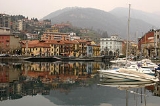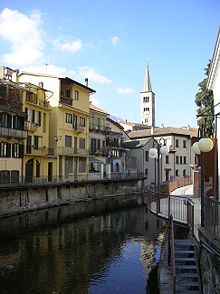
Omegna
Encyclopedia
Omegna is a comune
(municipality) in the Province of Verbano-Cusio-Ossola
in the Italian
region Piedmont
, located about 100 km northeast of Turin
and about 13 km southwest of Verbania
at the northernmost point of Lago d’Orta and traversed by the Nigoglia
, the lake’s sole outflow.

of Cireggio, archaeological findings dating from the late Bronze
and Iron Age
s. Omegna is mentioned in 1221 AD, when the population gave itself to the commune of Novara
.
In the 19th and early 20th century it became an industrial center (it was for many years the main centre for production of pots and small home appliances in Italy) and the population was increased by immigrants. In 1913 Omegna was connected with Pallanza by an electrical tramway line. It was declared a city in 1939. During World War II
it was a center of partisan resistance against the German-Fascist occupation.
Comune
In Italy, the comune is the basic administrative division, and may be properly approximated in casual speech by the English word township or municipality.-Importance and function:...
(municipality) in the Province of Verbano-Cusio-Ossola
Province of Verbano-Cusio-Ossola
Verbano-Cusio-Ossola is the northernmost province in the Italian region of Piedmont. It was created in 1996 through the fusion of three distinct regions which had previously been part of the Province of Novara...
in the Italian
Italy
Italy , officially the Italian Republic languages]] under the European Charter for Regional or Minority Languages. In each of these, Italy's official name is as follows:;;;;;;;;), is a unitary parliamentary republic in South-Central Europe. To the north it borders France, Switzerland, Austria and...
region Piedmont
Piedmont
Piedmont is one of the 20 regions of Italy. It has an area of 25,402 square kilometres and a population of about 4.4 million. The capital of Piedmont is Turin. The main local language is Piedmontese. Occitan is also spoken by a minority in the Occitan Valleys situated in the Provinces of...
, located about 100 km northeast of Turin
Turin
Turin is a city and major business and cultural centre in northern Italy, capital of the Piedmont region, located mainly on the left bank of the Po River and surrounded by the Alpine arch. The population of the city proper is 909,193 while the population of the urban area is estimated by Eurostat...
and about 13 km southwest of Verbania
Verbania
Verbania is a city and comune on the shore of Lake Maggiore, Piedmont, in northwest Italy, about north-west of Milan and about from Locarno in Switzerland.-Overview:...
at the northernmost point of Lago d’Orta and traversed by the Nigoglia
Nigoglia
The Nigoglia is a short Italian river whose source is at the northern end of Lago d’Orta, of which it is the sole outflow. Its course of less than 2 kilometres passes in a northerly direction through the town of Omegna and into the Strona....
, the lake’s sole outflow.

History
The presence of ancient settlement in the area has been proved by excavations held in the frazioneFrazione
A frazione , in Italy, is the name given in administrative law to a type of territorial subdivision of a comune; for other administrative divisions, see municipio, circoscrizione, quartiere...
of Cireggio, archaeological findings dating from the late Bronze
Bronze Age
The Bronze Age is a period characterized by the use of copper and its alloy bronze as the chief hard materials in the manufacture of some implements and weapons. Chronologically, it stands between the Stone Age and Iron Age...
and Iron Age
Iron Age
The Iron Age is the archaeological period generally occurring after the Bronze Age, marked by the prevalent use of iron. The early period of the age is characterized by the widespread use of iron or steel. The adoption of such material coincided with other changes in society, including differing...
s. Omegna is mentioned in 1221 AD, when the population gave itself to the commune of Novara
Novara
Novara is the capital city of the province of Novara in the Piedmont region in northwest Italy, to the west of Milan. With c. 105,000 inhabitants, it is the second most populous city in Piedmont after Turin. It is an important crossroads for commercial traffic along the routes from Milan to Turin...
.
In the 19th and early 20th century it became an industrial center (it was for many years the main centre for production of pots and small home appliances in Italy) and the population was increased by immigrants. In 1913 Omegna was connected with Pallanza by an electrical tramway line. It was declared a city in 1939. During World War II
World War II
World War II, or the Second World War , was a global conflict lasting from 1939 to 1945, involving most of the world's nations—including all of the great powers—eventually forming two opposing military alliances: the Allies and the Axis...
it was a center of partisan resistance against the German-Fascist occupation.
Main sights
- Church of Sant'Ambrogio. It is a late-RomanesqueRomanesque architectureRomanesque architecture is an architectural style of Medieval Europe characterised by semi-circular arches. There is no consensus for the beginning date of the Romanesque architecture, with proposals ranging from the 6th to the 10th century. It developed in the 12th century into the Gothic style,...
building with a nave and two aisles, with side chapels. The bell tower is still mostly the medieval one. The interior is now in BaroqueBaroqueThe Baroque is a period and the style that used exaggerated motion and clear, easily interpreted detail to produce drama, tension, exuberance, and grandeur in sculpture, painting, literature, dance, and music...
style, and houses an altarpiece by Fermo Stella da Caravaggio (1547) and an urn with the relics of St. Vith, parton saint of Omegna. - Ponte Antico ("Ancient Bridge", 15th century), over the StronaStrona (river)The Strona is a mountain torrent in the Province of Verbano Cusio Ossola, northern Italy, a tribitury of the Toce. It rises on Monte Capezzone at an elevation of 2,421 m and runs through the Valle Strona before entering the Toce...
river. - Porta della Valle ("Valley Gate", c. 1100 AD), also known as Porta Romana. It is the only surviving one among the five medieval gates of Omegna.
- Museum of Arts and Industry Forum.

